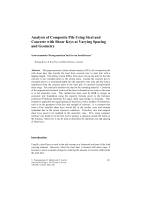Bridges

- Publication no: ABC-DES004-11
- Published: 31 October 2011
- PDF (free) Download
This paper presents a finite element analysis (FEA) of a composite pile with shear keys that transfer the load from concrete pier to steel pile with a lapping length. This piling system differs from most cast-in-situ piles in that the concrete is not extended down to the strong strata. Instead the concrete pier is extended down to a nominated depth into the anaerobic zone only and the load is transferred from the concrete piers to the steel pile via internal circumferential shear rings. The steel pile transfers the load to the founding material. Corrosion of the unprotected structural section of the liner is deemed not to occur as this area is in the anaerobic zone. This method has been used by KBR to design an economic pile foundation using the capacity formula given in the literature (American Petroleum Institute) for major multi span bridge in Australia. This formula is applicable for equal spacing of shear keys with a number of limitations, such as in the geometry of the key and strength of concrete. It is common that some of the installed shear keys would fall in the aerobic zone and become redundant due to the severe exposure conditions. Therefore, new and unequal shear keys need to be installed in the anaerobic zone. FEA using computer software was found to be the best tool to analyse a situation outside the limits in the formula. Moreover, it can be used to determine the optimum size and spacing of shear keys.
